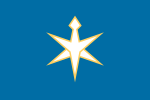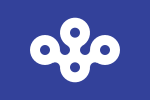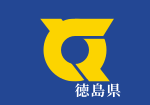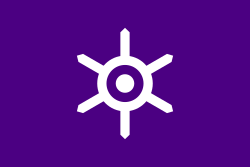Flags of Japanese prefectures
Appearance
This article needs additional citations for verification. (July 2024) |
You can help expand this article with text translated from the corresponding article in Japanese. (May 2022) Click [show] for important translation instructions.
|
Each modern Japanese prefecture has a unique flag, most often a bicolour, geometric, highly stylised design, and often incorporating the characters of the Japanese writing system and resembling minimalistic company logos.[1] The heraldic badges worn by warriors in medieval Japan (mon) were forerunners of the modern emblems used in the prefectural flags.[2]
A distinct feature of these flags is that they use a palette of colours not usually found in flags, including orange, purple, aquamarine and brown.
Some prefectures also have alternative official flags called "symbol flags" (シンボル旗). They may be used on less formal occasions. Famous symbol flags include the one used in Tokyo.
Flags by prefecture
[edit]| Flag | Prefecture | Geocode | Date of adoption | Description |
|---|---|---|---|---|
 |
Aichi | JP-23 | August 15, 1950 | Stylised hiragana of the あ in あいち (Aichi). The emblem also expresses sunrise and wave to indicate Aichi's location facing the Pacific Ocean. |
 |
Akita | JP-05 | November 3, 1959 | Stylized katkana character "ア" ("a") on a dark red field. |
 |
Aomori | JP-02 | January 1, 1961 | Stylised map of the prefecture in green on a white field.. |
 |
Chiba | JP-12 | July 29, 1963 | a blue field with "チハ" ("Chiba") stylized into a rapeseed flower. |
 |
Ehime | JP-38 | May 5, 1952 | Horizontal tricolor of yellow, green and yellow with a orange blossom |
 |
Fukui | JP-18 | March 28, 1952 | A dark blue field charged with a circular emblem consisting of the katakana "フクイ" ("Fukui") stylized into a young leaf growing next to two other leaves. |
 |
Fukuoka | JP-40 | May 10, 1966 | The hiragana "ふく" ("Fuku") stylized into a plum blossom. |
 |
Fukushima | JP-07 | October 23, 1968 | orange field with the hiragana character "ふ" ("fu") stylized into a circle in the canton. |
 |
Gifu | JP-21 | August 10, 1932 | A white field charged with a green stylized "岐" ("Gi") inside of a green circle. |
 |
Gunma | JP-10 | October 25, 1968 | A purple field charged with a stylized kanji "群" (pronounced "Gun") surrounded by three white crescents symbolizing Mt. Akagi, Mt. Horuna and Mt. Myōgi. |
 |
Hiroshima | JP-34 | July 23, 1966 | Katakana character "ヒ" stylized into two attached circular crescents on a maroon red field. |
 |
Hokkaidō | JP-01 | May 1, 1967 | a navy blue field charged with a red 7-pointed star with a thick white fringe around the star. |
 |
Hyōgo | JP-28 | June 10, 1964 | Kanji character "兵" ("Hyō") stylized into waves on a light blue field. |
 |
Ibaraki | JP-08 | November 13, 1991 | a white stylized rose bud on a field of indigo. |
 |
Ishikawa | JP-17 | October 1, 1972 | Stylized kanji of 石川 (Ishikawa) on a cerulean blue field. |
 |
Iwate (detail) | JP-03 | March 6, 1965 | a bluish-gray field charged with the kanji 岩 (iwa) stylized with vertical and horizontal symmetry |
 |
Kagawa | JP-37 | October 1, 1977 | An olive green field charged with a stylized and rotated katakana "カ" (ka) |
 |
Kagoshima (detail) | JP-46 | March 10, 1967 | A black horseshoe shape (representing the Satsuma and Osumi Peninsulas) with a small dent on the bottom-right corner of the emblem (representing Shibushi Bay) surrounding a red circle (representing Sakurajima). |
 |
Kanagawa | JP-14 | November 4, 1948 | stylized Kanji character "神" (kami) in red on a white field. |
 |
Kōchi | JP-39 | April 15, 1953 | a maroon red field charged with "と" and "コ" stylized into a sword pointing up. |
 |
Kumamoto | JP-43 | March 31, 1966 | A maroon field charged with a white ク (ku) stylized into Kyushu. |
 |
Kyoto | JP-26 | November 2, 1976 | a violet field charged with a white 6-petal flower with a yellow dot in its center. |
 |
Mie | JP-24 | April 20, 1964 | A green field charged with a white み stylized into an arrow pointing up. |
 |
Miyagi | JP-04 | July 15, 1966 | A green field charged with a white み stylized into a bush clover/miyaginohagi. |
 |
Miyazaki | JP-45 | December 22, 1964 | a green field with a yellow ミ (mi) stylized into three stairs |
 |
Nagano | JP-20 | March 20, 1967 | An orange field charged with a white disc consisting of a stylized katakana "ナ" (na). |
 |
Nagasaki | JP-42 | August 30, 1991 | a white field charged with a light blue N stylized into the form of a dove. |
 |
Nara | JP-29 | March 1, 1968 | a white field charged with a maroon ナ (na) stylized into a circle. |
 |
Niigata | JP-15 | August 23, 1968 | Red field charged with a gold stylized Kanji character 新 (nii) and Katakana characters ガタ (gata) of Niigata on red field. |
  |
Ōita | JP-44 | July 24, 1966 | a white field charged with three red kanji 大 (o) stylized and arranged in a circle. the variant has the prefecture's full name in Japanese Kanji (大分県) at the bottom-hoist corner. |
 |
Okayama | JP-33 | November 22, 1967 | A dark purple field charged with a yellow 岡 stylized into a circle. |
 |
Okinawa (detail) | JP-47 | October 13, 1972 | A white field charged with a white O inside of a red disc. |
 |
Ōsaka | JP-27 | June 21, 1968 | A blue field charged with three white O's branched to another O. |
 |
Saga | JP-41 | December 11, 1968 | A green field charged with a white camphor flower. |
 |
Saitama | JP-11 | September 1, 1964 | A white field charged with 16 re ornamental beads arranged in a circle. |
 |
Shiga | JP-25 | September 16, 1968 | a light blue field charged with a white emblem consisting of シガ (Shiga) stylized into a circle with wings. |
 |
Shimane | JP-32 | November 8, 1968 | A dark red field charged with four yellow katakana マ (ma) circularly stylized and arranged into a cloud-shaped circle |
 |
Shizuoka | JP-22 | August 26, 1968 | A blue field with an orange emblem consisting of a stylization of both the map of the prefecture and Mount Fuji. the emblem is thickly fimbriated with white. |
 |
Tochigi | JP-09 | March 1, 1964 | A light green field charged with an emblem consisting of the kanji 栃 (tochi) heavily stylized. the top-left corner of the emblem is a white rectangle with three upward pointing arrows, that being a stylization of the ancient Chinese character 木 (gi). |
  |
Tokushima | JP-36 | March 18, 1966 | A blue field charged with a yellow emblem consisting of the hiragana とく (toku) stylized into a flying bird. the alternative version consists of the prefecture's name in kanji (徳島県) on the bottom right. |
 |
Tokyo (detail) | JP-13 | October 1, 1964 | A six-rayed stylised sun with a dot in the center. The background color is Edo purple (江戸紫, Edo murasaki), which was popular in Edo, the name of Tokyo during the Edo period. This shade of purple is one of the traditional colors of Japan, and is near identical to Web Indigo. |
 |
September 30, 1989 | A stylised green Ginkgo biloba leaf. The symbol consists of three arcs combined to resemble a leaf of the ginkgo, the metropolitan tree, and represents T for Tokyo. Created by Rei Yoshimura (レイ吉村), a professional graphic designer. | ||
 |
Tottori | JP-31 | October 23, 1968 | A blue field charged with a white emblem consisting of the hiragana と (to) stylized into a flying bird. |
 |
Toyama | JP-16 | December 27, 1988 | A white field charged with a green emblem consisting of the hiragana と (to) stylized together with Mount Tateyama. |
 |
Wakayama | JP-30 | August 7, 1969 | A white field consisting of a blue emblem, which in turn consists of a katakana ヮ (wa) stylized into an open fan. |
 |
Yamagata | JP-06 | March 26, 1963 | A blue field charged with three white mountain peaks (possibly stylization of the kanji 山) with a triangular indentation on each peak. |
 |
Yamaguchi | JP-35 | September 3, 1962 | A brown field charged with the kanji 山口 (Yamaguchi) stylized into a bird flying towards the sun. |
 |
Yamanashi | JP-19 | December 1, 1966 | A magenta field charged with three orange stylized 人 combined to form a stylized 山 enclosed by a white trapezoid representing Mount Fuji. |
Symbol mark flag
[edit]-
Symbol mark flag of Kagoshima Prefecture
-
Symbol mark flag of Tokyo
Historical flags
[edit]-
Toyama Prefecture (1957–1988)
-
Osaka Prefecture (1968–1984)
-
Kumamoto Prefecture (1960)
-
Yamagata Prefecture (1963–1971)
-
Fukushima Prefecture (1951–1968)
-
Ibaraki Prefecture (1966–1991)
-
Ehime Prefecture (1989–1999)
-
Nagasaki Prefecture (1991, unofficial)
-
Okinawa Prefecture (24 April–15 May 1972)
-
Okinawa Prefecture (15 May–13 October 1972)
-
Karafuto Prefecture (1911–1949)
See also
[edit]References
[edit]- ^ "DESIGN IN FLAGS: THE BEAUTY FOUND IN JAPAN'S FLAGS". DESIGN MADE IN JAPAN. Retrieved July 21, 2024.
- ^ Inglefield, Eric (1984). Flags. Arco Pub. p. 18. ISBN 0-668-06262-2.













